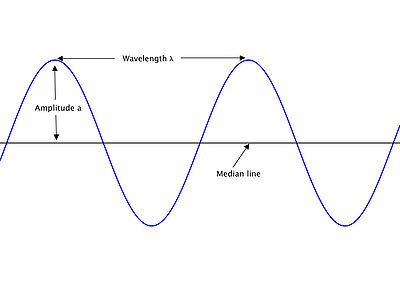Electromagnetic wave
The image below is of a pure sine wave <math> y = sinx </math>
- The Amplitude of the wave a is the distance from the median line of the wave to either a peak or a trough.
- The wavelength <math> \lambda </math> is the distance betwwen two corresponding point on successive waves, and is measured in metres.
- The period of a wave is the time it takes for it to pass a fixed reference point, and is measured in seconds.
- Frequency is the number of waves that pass a fixed reference point per second, with units Hertz (Hz) where 1 Hz = 1 complete cycle per second.
The velocity of electromagnetic waves is close to the speed of light in the atmosphere, approximately 300 000 000 m/s.
Basic formulas
- Period = 1/frequency <math> p = \frac {1}{f} </math>
- Velocity = Frequency x Wavelength <math> v = f \times \lambda </math>
Since velocity is the speed of light and is constant, we denote it with the letter c:
<math>c = f \times \lambda</math>
This allows us to deduce the wavelength from the frequency and vice-versa.
Calculating the wavelength from frequency and vice versa
From the above, we can infer that the frequency can be calculated from the wavelength using:
<math>f = \frac{300 000 000m/s}{\lambda}</math>
and the reverse, calculating the wavelength from the frequency, is a similar operation:
<math>\lambda = \frac{300 000 000m/s}{f}</math>
This should be familiar to people that studied algebra.
Note that most of the time, since those numbers are so high, most operators prefer to operate with the mega prefix, so the formulas become simpler:
<math>\lambda = \frac{300Mm/s}{f'}</math>
<math>f' = \frac{300Mm/s}{\lambda}</math>
Here, f' is in Mhz and a Mm/s is a mega-meter per second.
Basic tricks
- Just dive 300 by the number you have to get the number you want.
- Don't forget to convert to megahertz first.
- Wavelength is always in meters.
Example calculations
Calculating the frequency
The frequency of a 20m radio wave is:
<math> c = f \times \lambda</math>
<math>300 000 000m/s = f \times 20m</math>
<math>f = \frac{300 000 000m/s}{20m}</math>
Therefore, the frequency is 15Mhz (15 000 000/s or 15 000 000Hz).
An easier way to calculate this is treat c as "300Mm/s" (300 megameters per second) and just divide by the wavelength (in meters) to get the frequency (in Megahertz).
<math>f = \frac{300Mm/s}{20m} = 150Mhz</math>
Calculating the wavelength
The reverse operation is of course possible and very similar.
<math>\lambda = \frac{c}{f}</math>
Here you would get the wavelength in meters, provided that f is in Hz. An easier way is to do the same as above and just use mega prefixes everywhere:
<math>\lambda = \frac{300}{f'}</math>
Here, f' is in Mhz. Finding the wavelength of a 447Mhz signal would be:
<math>\lambda = \frac{300}{447} = 0.6711m = 67.1cm</math>
This is in the 70cm band.
Those calculations are very useful to find the length of a good antenna, as antennas operate better when they have a size that is close to the wavelength or an integer multiple of the half-wavelength.
See also
| Electronic Theory | |
| Physical quantities | Current * Gain * Impedance * Power * Q of a circuit * Radiated Power Measurement * Reactance* Resistivity * Resonance * Voltage |
| Components | Baluns * Bipolar-Junction Transistors * Capacitors * Diodes * Inductors* Lasers * Microphones * Resistors * Transformers * Wire |
| Circuits | Attenuators * Digital Signal Processing (DSP) * Dummy load * Filters * LC filters * Power Supply Design * Rectifier Circuits |
| Design | Amplifier Design * Oscillator Design |
| Electromagnetic Waves | Relative power (Decibels) * Harmonics * Interference and BPL |
| Propagation and radio wave theory | |
| Propagation | Aurora * E-Skip * IPS * Lightning scatter * Meteor scatter * Satellites * Trans-Equatorial Propagation * Tropospheric ducting |
| Interference | QRM * QRN |
| Theory | Electromagnetic Waves * Frequency Wavelength and Period |
